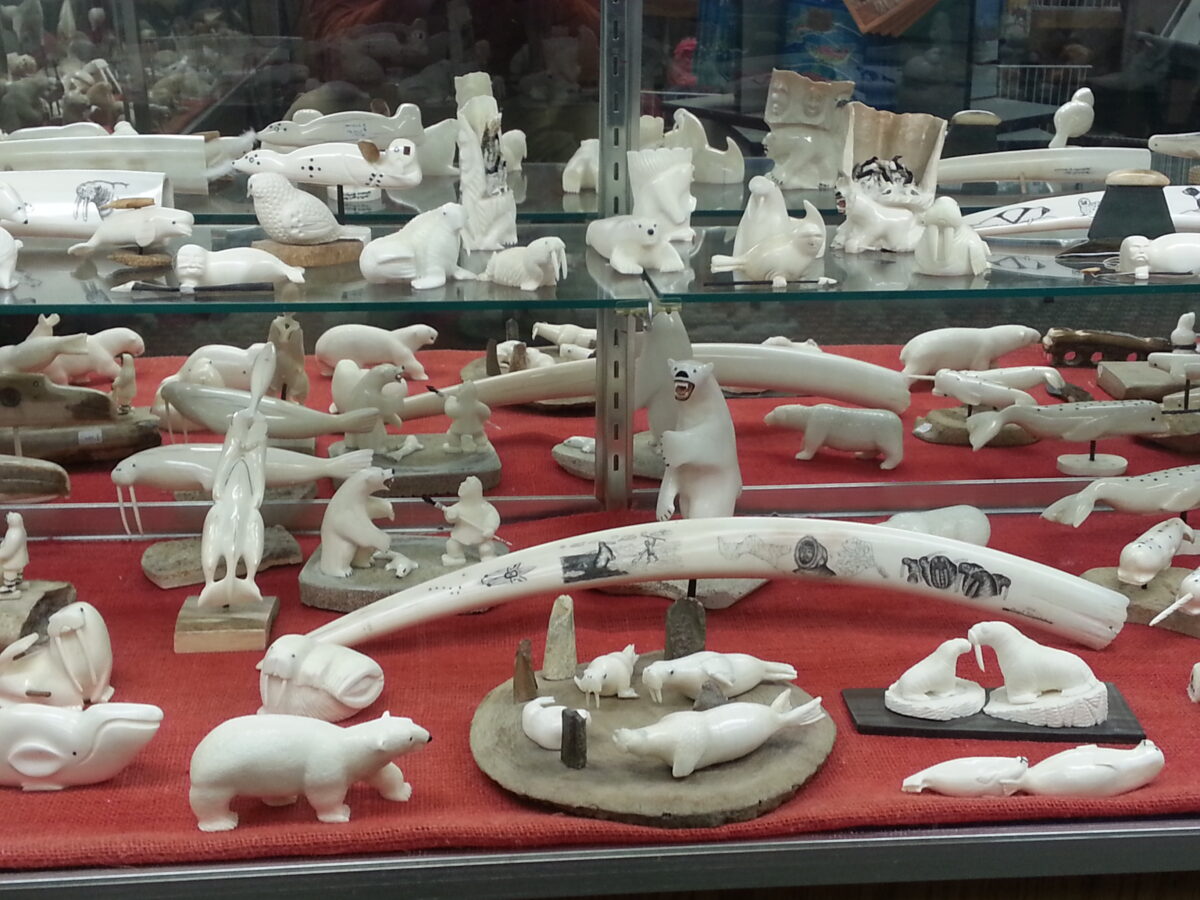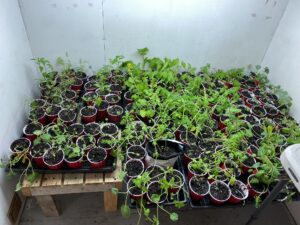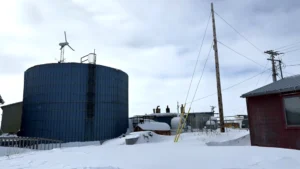With five different states’ ivory bans currently in effect, the latest passed by Hawaii at the beginning of this year, confusion remains among potential walrus ivory buyers in Alaska about what ivory is legal and what isn’t.
KNOM’s Davis Hovey reports:
Robert James is the manager of Maruskiya’s, a small business in Nome that sells local gifts and handmade crafts, including ivory carvings.
He says most of their ivory pieces, made from mastodon, whale bone, and walrus ivory, are all sold to a specific clientele.
“It’s a very client-based business,” stated James, “So we don’t necessarily have to get out there too much. I mean, the challenges are more and more so it might get to that point where we’ll have to. But a lot of times people will seek us out, or we have certain clients because we end up wholesaling a lot out of Nome. It’s a great place to buy, but we don’t get the foot-traffic like in Southeast or anywhere else.”
James is wrapping a mounted beluga whale, carved out of walrus ivory, for a couple of tourists from Washington state. According to James, the best months for ivory sales at Maruskiya’s are July through September, which is also when a few cruise ships, like the Crystal Serenity, make port in Nome.

Maruskiya’s receives and sells ivory pieces from Native carvers throughout the Bering Straits region. Susie Silook, a Native ivory carver from Gambell, recalls a time she addressed a tourist group in Nome and one potential ivory customer mentioned their hesitancy to make a purchase.
“They were scared to buy any ivory without a piece of paper that gives information on where it’s from and the fact that it is legal. In the elephant ivory ban, antiquities are allowed up to 100 years old, but it’s up to the owner to prove that this piece is 100 years old and, therefore, is legal,” explained Silook, “And people are worried about that, worried about having to prove that their item is actually legal.”
Silook feels that if carvers don’t get their artwork certified, then it will hurt their business.
James says even if they wanted to get certifications for the ivory Maruskiya’s sells, it’s just not feasible.
“And we can’t get any kind of formal documentation that says this is authentic, Native art. Ideally, we’d get it from CITES, which is the international trade exporting association, but it’s not that simple, because every time you apply for that, it’s on each individual piece, and there’s a huge fee each time,” James said, “So a lot of the time, it’s not worth (it), and it’s like a 3-6 month wait, so a lot of people aren’t going to wait that long, anyway.”
James believes it would take some clear legislation from the Alaska delegation to clarify the differences between walrus and elephant ivory as a way to reassure people who are concerned about buying ivory carvings.
Although that state legislation does not yet exist, Silook says an educational brochure is available that explains how Native Alaskans’ use of walrus ivory is excluded from an elephant ivory ban in the U.S., which was established by an executive order last year from President Barack Obama.
“Even though there’s an exemption for existing federal legislation permitting other items, which would be us under the Marine Mammal Protection Act, not many people are aware of, not just that law, but our legal use of walrus ivory. So this brochure is part of the ongoing effort by organizations to inform the American public about our legal, cultural use of walrus ivory in the hopes that states will not ban it along with other items they are attempting to ban as they respond to the executive order,” said Silook.
This Alaska Native Ivory brochure was created through collaboration between the Eskimo Walrus Commission (EWC), the Alaska State Council on the Arts, and others.
In Nome, Vera Metcalf serves as the Director of the Eskimo Walrus Commission. She explains how walrus and their ivory tusks are priceless in more ways than one.
“I’m from Savoonga, St. Lawrence Island, and I grew up with ivory. I have many relatives and friends who make crafts to make income,” stated Metcalf, “It is highly utilized and valued, so it is a valuable, beautiful piece of a resource that we have been utilizing for centuries. So part of it is like, it’s part of our identity, it’s part of our lifeways.”
Metcalf says the Commission is also working with the Alaska delegation to educate other state delegations about walrus ivory before they decide to implement more inclusive ivory bans.
As it stands, California, New York, New Jersey, Washington, and Hawaii all have their own state ivory legislation, some of which ban walrus ivory along with elephant ivory.
When asked if these state bans have affected Maruskiya’s ivory sales, James replied, “Oh absolutely, sure, and we’ve just had to adapt, find other clients. We used to go to California and do a show in San Francisco, but we can’t do that anymore. That was a big weekend for us, because we really only get out of Alaska and bring large amounts of inventory to a couple shows, and that was one of them. We aren’t panicking yet, but sure, it has affected sales.”
James is hopeful that the Alaska Native Ivory brochure will continue to educate his potential customers and help carvers in the region sell more pieces of ivory off Maruskiya’s shelves.
For now, James says Maruskiya’s will operate as usual and participate in a crafts show in Santa Fe, New Mexico, this August.





